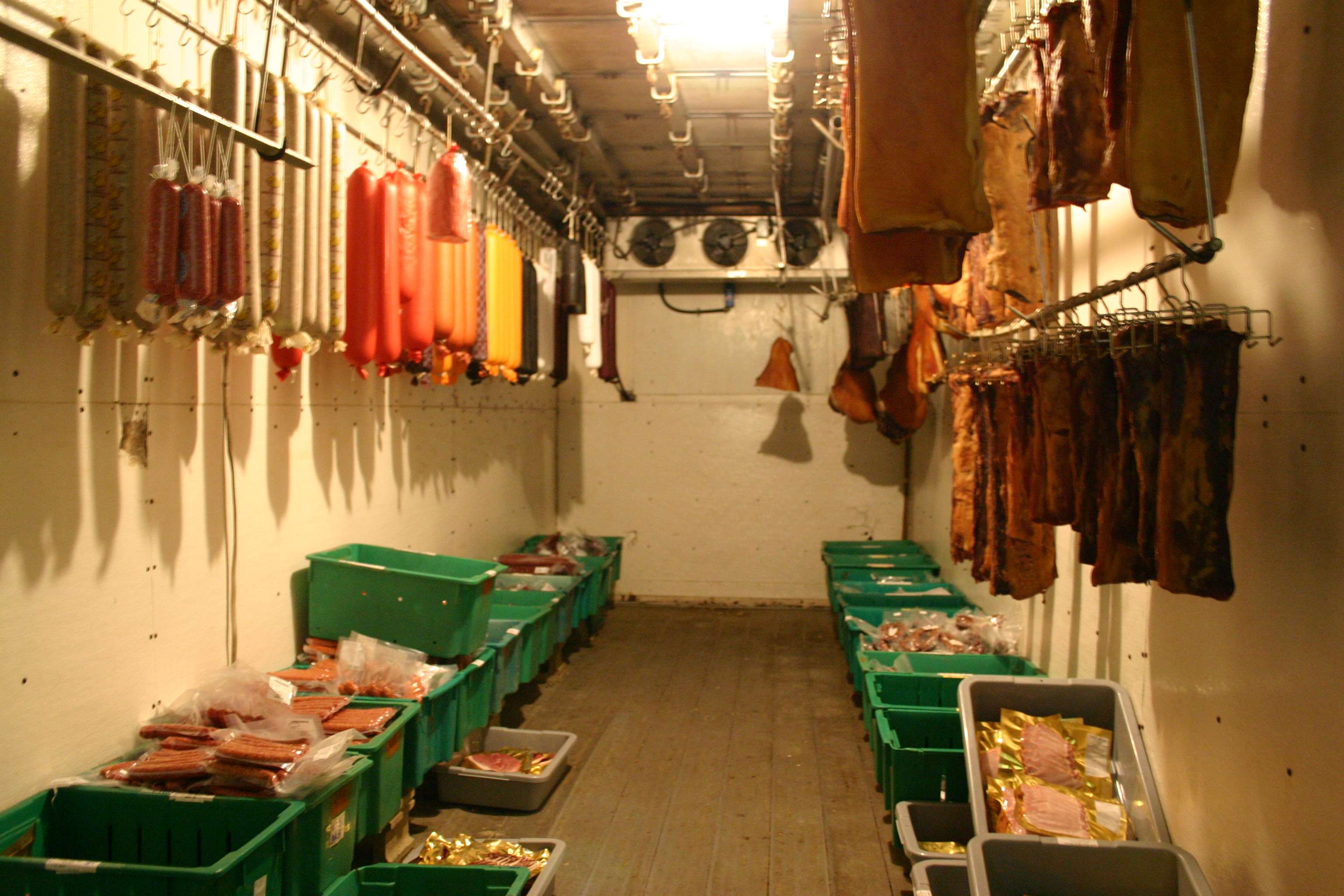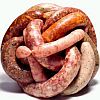I have been using Len's recipe for basterma for a couple of years now
with no ill effects friends and family love it
Basterma - is this right?
45 posts
• Page 2 of 3 • 1, 2, 3
Hi Zulululu,
Brisbane is very similar to Durban, weather and humidity wise. I have to start making my smoked biltong very shortly, my grandkids are always complaining that they ran out.
I will need to make heaps of fresh sausage too, cured/smoked beef, the list is endless.
The biggest problem I have is the temperature, it never seems to go below 20-22c.
Groetjes Mijnheer.
Jan.
Brisbane is very similar to Durban, weather and humidity wise. I have to start making my smoked biltong very shortly, my grandkids are always complaining that they ran out.
I will need to make heaps of fresh sausage too, cured/smoked beef, the list is endless.
The biggest problem I have is the temperature, it never seems to go below 20-22c.
Groetjes Mijnheer.
Jan.
- crustyo44
- Registered Member
- Posts: 640
- Joined: Thu Oct 07, 2010 12:00 am
- Location: Brisbane.Australia
Just started curing last night using Len's recipe (I replaced fenugreek with ground mustard, as a number of sources seemed to list it as a substitute). Seemed like an awful lot of cure mix for the meat -- after coating it and really packing it on there was still a lot leftover, but I put everything in the ziploc and I'll be massaging it in every day just to make sure it all gets used.
I'll let you know how this all turns out in about 10 days!
I'll let you know how this all turns out in about 10 days!
Big Onion
http://www.mronionsneighborhood.com/
http://www.mronionsneighborhood.com/
- big_onion
- Registered Member
- Posts: 66
- Joined: Tue Mar 01, 2011 9:07 pm
- Location: New Orleans, LA
big_onion wrote:Just started curing last night using Len's recipe (I replaced fenugreek with ground mustard, as a number of sources seemed to list it as a substitute). Seemed like an awful lot of cure mix for the meat -- after coating it and really packing it on there was still a lot leftover, but I put everything in the ziploc and I'll be massaging it in every day just to make sure it all gets used.
I'll let you know how this all turns out in about 10 days!
I moved it to the little temperature controlled minifridge last night -- a day early -- and sliced off a little piece. It tasted amazing! I'm looking forward to how it is after drying out a bit. I thought substituting the mustard would give it too tangy a flavor, but it was actually pretty great, and it tasted like the cure penetrated all the way through.
I am a little concerned that I don't have enough room to hang it in this fridge -- it's on a rack right now, and I'll plan on turning it every day (or more). Plus, since it's so little a fridge I have no way of circulating air in there, so opening the thing up once in awhile will hopefully do it some good.
I'll report back once it's done drying.
Big Onion
http://www.mronionsneighborhood.com/
http://www.mronionsneighborhood.com/
- big_onion
- Registered Member
- Posts: 66
- Joined: Tue Mar 01, 2011 9:07 pm
- Location: New Orleans, LA
Big_onion, what is the result? It was supposed to be ready, no? Today i put 1kg of sirloin covered with all spices from the recipe, although put only 2.5 grams of Cure#1. Did you stick exactly to the recipe with the amount of Cure#1? Don't you think it's too much? And another question: what is the temperature that you have in your temperature controlled minifridge? I'm from Israel and it's kinda complicated to get airy place of 65F. And in fridge it is too low....
- viking
- Registered Member
- Posts: 12
- Joined: Sat Jun 04, 2011 8:34 pm
- Location: Israel
viking wrote:Guys, can anyone explain why the 65F is crucial for the successful aging process? Can't it take place in colder environment, like 42-50F?
Thanks in advance....
That's because the beneficial microorganisms we take advantage of in cured sausages (Lactobacillus, Nitrobacter, sometimes Penicillium) work best in that temperature range. Too low or too high temperature might give unwanted pathogenic bacteria an advantage. Also, it's for gastronomical reasons since the organoleptic and enzymatic processes that make the cured product a delicacy rather than a dried and salty slab of meat work best at that temperature without deteriorating the product too soon.
André
I have a simple taste - I'm always satisfied with the best.
I have a simple taste - I'm always satisfied with the best.
- grisell
- Registered Member
- Posts: 3171
- Joined: Sun Oct 04, 2009 6:17 pm
- Location: Stockholm, Sweden
grisell wrote:viking wrote:Guys, can anyone explain why the 65F is crucial for the successful aging process? Can't it take place in colder environment, like 42-50F?
Thanks in advance....
That's because the beneficial microorganisms we take advantage of in cured sausages (Lactobacillus, Nitrobacter, sometimes Penicillium) work best in that temperature range. Too low or too high temperature might give unwanted pathogenic bacteria an advantage. Also, it's for gastronomical reasons since the organoleptic and enzymatic processes that make the cured product a delicacy rather than a dried and salty slab of meat work best at that temperature without deteriorating the product too soon.
Don't believe everything you hear

-

BriCan - Registered Member
- Posts: 2203
- Joined: Wed Apr 07, 2010 12:07 am
- Location: West Coast of Canada
I'm not saying it can't be done at lower temperatures, I'm saying that it is highly beneficial at 12 C because of the reasons I wrote above.
André
I have a simple taste - I'm always satisfied with the best.
I have a simple taste - I'm always satisfied with the best.
- grisell
- Registered Member
- Posts: 3171
- Joined: Sun Oct 04, 2009 6:17 pm
- Location: Stockholm, Sweden
André, Please understand I was not picking on you or trying to belittle you in any way. Probably came across bad due to the medication I’m on for my blown knee. What you have stated is correct but where I was coming from was that you had not really answered (in my mind at least) the question asked.
As said, I feel that you only partially answered the question; the first part but not the second part. Again the question was about ageing and is not about curing which also means that 65F is not crucial the successful ageing.
If we are talking about ageing then a lower temperature (42-50F) is beneficial for numerous reasons; less chance of case hardening (this does not mean to say that it will not happen), a longer maturing time means (usually) better flavour, no reason to use starter cultures as we are not in a rush to get finished, less chance of product loss (I just lost 4 hams due to higher temperatures 65F).
If we look at the way we do things the outcome seems logical. I realise that home curers have to make adjustments of space and sometimes time. The latter (time) is not a thing to mess with unless you truly know what you are doing as time is the key to not just a mediocre product but a fine product that shines every time.
In the following photos there are at least 120 kg salami, 10-12 beef loins, 20 pork loins (lonzino), 20+ Blunderflesh and 6 Schinkenspeck and they are ageing at low temperatures



Guys, can anyone explain why the 65F is crucial for the successful ageing process? Can't it take place in colder environment, like 42-50F?
As said, I feel that you only partially answered the question; the first part but not the second part. Again the question was about ageing and is not about curing which also means that 65F is not crucial the successful ageing.
If we are talking about ageing then a lower temperature (42-50F) is beneficial for numerous reasons; less chance of case hardening (this does not mean to say that it will not happen), a longer maturing time means (usually) better flavour, no reason to use starter cultures as we are not in a rush to get finished, less chance of product loss (I just lost 4 hams due to higher temperatures 65F).
If we look at the way we do things the outcome seems logical. I realise that home curers have to make adjustments of space and sometimes time. The latter (time) is not a thing to mess with unless you truly know what you are doing as time is the key to not just a mediocre product but a fine product that shines every time.
In the following photos there are at least 120 kg salami, 10-12 beef loins, 20 pork loins (lonzino), 20+ Blunderflesh and 6 Schinkenspeck and they are ageing at low temperatures



-

BriCan - Registered Member
- Posts: 2203
- Joined: Wed Apr 07, 2010 12:07 am
- Location: West Coast of Canada
That's okay, BriCan. No offense taken.  Sorry to hear about your knee. Hope you get better soon!
Sorry to hear about your knee. Hope you get better soon!
I'm still a little dubious though. I'm thinking about psychrophile bacteria such as Pseudomonas spp. These thrive at temperatures below 10 C/50 F and are especially hazardous since they are resistant to most antibiotics. Also, are you certain that lactic acid and nitric bacteria can do their job at the 3 C/37 F you show in your picture? As is well known, the nitric bacteria are responsible for reducing nitrate (either artificial or natural) to nitrite, providing botulism protection. Naturally, infection problems are more likely to occur in composite products such as sausages than in whole muscles. Then there are the enzymatic processes that convert the products to their matured state. Do they work? Then we have the mould (if using). I'm not sure it will grow well at low temperatures.
What I said above are only my theories. Whether they hold in practice I don't know. Do we have any microbiologists on the forum that can confirm or deny them?
I'm still a little dubious though. I'm thinking about psychrophile bacteria such as Pseudomonas spp. These thrive at temperatures below 10 C/50 F and are especially hazardous since they are resistant to most antibiotics. Also, are you certain that lactic acid and nitric bacteria can do their job at the 3 C/37 F you show in your picture? As is well known, the nitric bacteria are responsible for reducing nitrate (either artificial or natural) to nitrite, providing botulism protection. Naturally, infection problems are more likely to occur in composite products such as sausages than in whole muscles. Then there are the enzymatic processes that convert the products to their matured state. Do they work? Then we have the mould (if using). I'm not sure it will grow well at low temperatures.
What I said above are only my theories. Whether they hold in practice I don't know. Do we have any microbiologists on the forum that can confirm or deny them?
André
I have a simple taste - I'm always satisfied with the best.
I have a simple taste - I'm always satisfied with the best.
- grisell
- Registered Member
- Posts: 3171
- Joined: Sun Oct 04, 2009 6:17 pm
- Location: Stockholm, Sweden
Grisell
Given that BriCan is a commercial supplier in Canada and presumably (therefore) his meat is subject to scrutiny/testing by the Canadian Public Health authorities, I think that we can be fairly certain that his process is safe.
(No doubt his xx years experience is also of help - actual years omitted to spare the innocent - but I have it on good authority that he knew Moses! )
)
Phil
Given that BriCan is a commercial supplier in Canada and presumably (therefore) his meat is subject to scrutiny/testing by the Canadian Public Health authorities, I think that we can be fairly certain that his process is safe.
(No doubt his xx years experience is also of help - actual years omitted to spare the innocent - but I have it on good authority that he knew Moses!
Phil
-

wheels - Global Moderator
- Posts: 12891
- Joined: Sat Sep 02, 2006 4:29 pm
- Location: Leicestershire, UK
I'm not questioning his experience. I raised a few scientific questions. I also have information from experts on food microbiology at the Swedish National Food Administration answering a question of mine about temperatures of storing and maturing salami. The answer reads, I quote (my bad translation):
"--- It follows that it there is not established any specific temperature requirements that must be observed in air drying of salami. The requirements of the general rules of hygiene (Annex II to Regulation (EC) No 852/2004) must be met. Salami must therefore be kept at temperatures that don't cause a risk to health. From a microbiological perspective, it is usually better if salami stored at room temperature than refrigerated. This is because EHEC and other harmful bacteria die faster the hotter salami stored. However, it is your responsibility as a food business to ensure that the relevant requirements of food law are met (cf. inter alia Article 17 of Regulation (EC) No 178/2002)."
I have no reason to doubt their expertise, but I'm always willing to hear second opinions that are based on science and not on experience alone.
"--- It follows that it there is not established any specific temperature requirements that must be observed in air drying of salami. The requirements of the general rules of hygiene (Annex II to Regulation (EC) No 852/2004) must be met. Salami must therefore be kept at temperatures that don't cause a risk to health. From a microbiological perspective, it is usually better if salami stored at room temperature than refrigerated. This is because EHEC and other harmful bacteria die faster the hotter salami stored. However, it is your responsibility as a food business to ensure that the relevant requirements of food law are met (cf. inter alia Article 17 of Regulation (EC) No 178/2002)."
I have no reason to doubt their expertise, but I'm always willing to hear second opinions that are based on science and not on experience alone.
André
I have a simple taste - I'm always satisfied with the best.
I have a simple taste - I'm always satisfied with the best.
- grisell
- Registered Member
- Posts: 3171
- Joined: Sun Oct 04, 2009 6:17 pm
- Location: Stockholm, Sweden
45 posts
• Page 2 of 3 • 1, 2, 3
Return to Recipes for cured meats
Who is online
Users browsing this forum: No registered users and 14 guests

